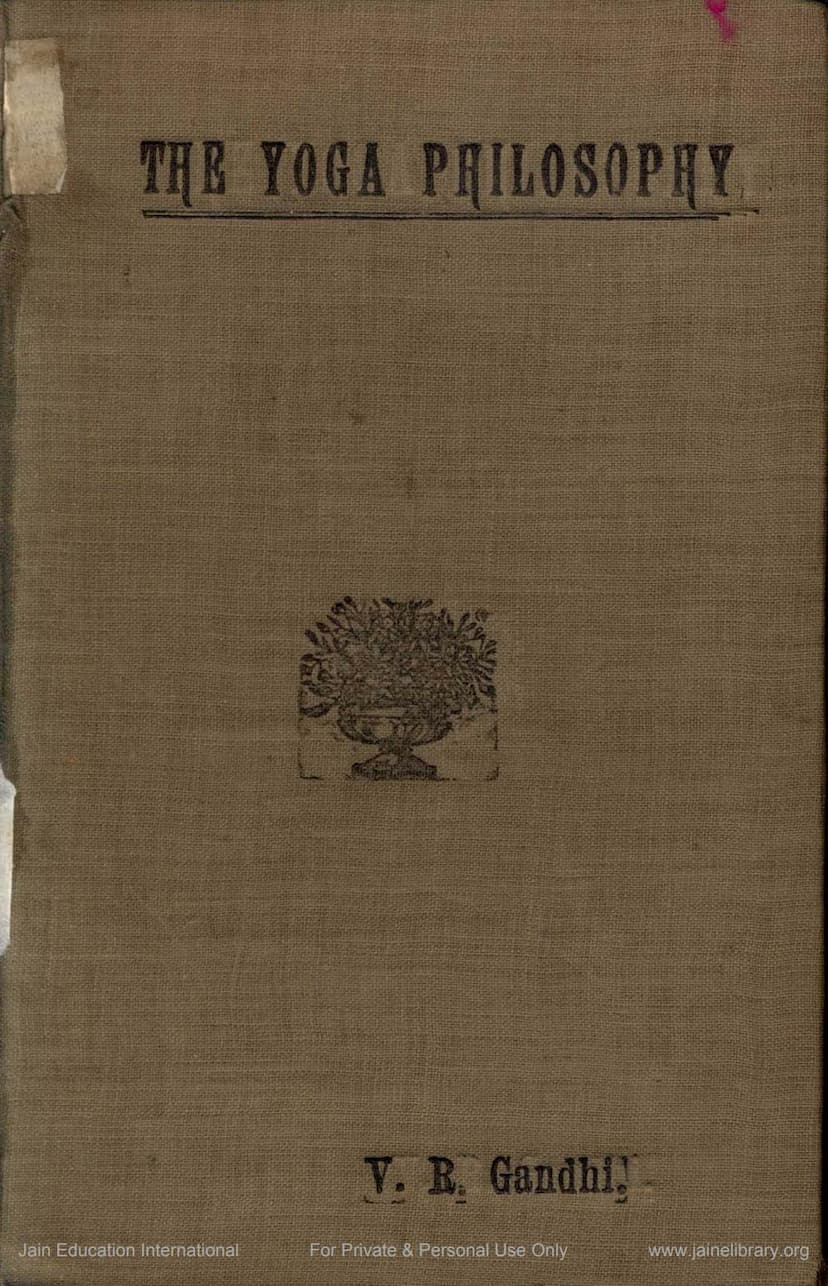Yoga Philosophy
Added to library: September 2, 2025

Summary
Here's a comprehensive summary of the Jain text "The Yoga Philosophy" by Virchand R. Gandhi and Bhagu F. Karbhari, based on the provided document:
Book Title: The Yoga Philosophy Author(s): Virchand R. Gandhi, Bhagu F. Karbhari Publisher: Agamoday Samiti Publication Date: Second Edition, 1924
Overview:
"The Yoga Philosophy" is a collection of speeches and writings by Virchand R. Gandhi, a prominent Jain delegate and scholar, aiming to explain the intricate philosophy and practice of Yoga from a Jain perspective. The book aims to make this ancient and profound subject accessible to the modern generation and Western scholars. The publisher, Shree Agamodaya Samiti, highlights the immense depth of Yoga, with centuries of scholarly work dedicated to it, and commends Gandhi's ability to grasp and simplify this complex subject. The book touches upon various related themes such as mysticism, soul culture, occult powers, hypnotism, the science of breathing, magnetism, Pranayama, and Tantras.
Key Themes and Concepts:
- Yoga as a Complement to Sankhya: The text establishes Yoga as a practical complement to the analytical philosophy of Sankhya. While Sankhya provides a detailed enumeration and analysis of the universe, Yoga offers the practical methods to achieve liberation and knowledge.
- The Nature of Yoga: Yoga is defined as the "suppression of the transformations of the thinking principle" (Vritti-nirodha). This involves controlling the modifications of the mind to achieve a state of mental stillness and ultimately, self-realization.
- The Thinking Principle (Antah-Karana): The book explains the "thinking principle" as the Antah-Karana, which comprises Manas (mind), Chitta (individualizing consciousness), Ahankara (ego), and Buddhi (reason). Yoga aims to still the transformations of these faculties.
- The Eight Limbs of Yoga: The text outlines the eight stages of Yoga as described in classical texts: Yama (ethical restraints), Niyama (observances), Asana (postures), Pranayama (breath control), Pratyahara (sense withdrawal), Dharana (concentration), Dhyana (meditation), and Samadhi (absorption/enlightenment).
- Yama: Emphasizes ethical conduct like non-violence (Ahimsa), truthfulness, non-stealing, celibacy, and non-possessiveness. Gandhi stresses the importance of Ahimsa, extending it to abstaining from animal food and all forms of harm.
- Niyama: Focuses on observances like purity (physical and mental), contentment, austerity, self-study, and surrender to the Divine.
- Asana and Pranayama: The text details the importance of physical postures and breath control (Pranayama) in preparing the body and mind for higher yogic practices. Pranayama is described as crucial for regulating vital energies and is presented as having both physical and spiritual benefits.
- Pratyahara, Dharana, Dhyana, Samadhi: These stages represent the progressive inward withdrawal of the senses, sustained concentration, deep absorption, and ultimately, the state of liberation or Samadhi.
- The Goal of Yoga (Kaivalya/Moksha): The ultimate aim of Yoga is Kaivalya or Moksha, a state of liberation, pure consciousness, and supreme bliss where the soul realizes its true nature, free from the disturbances of matter and the mind.
- Distinction between Mind and Soul: The book clearly differentiates between the soul (Purusha), which is eternal consciousness, and the mind (thinking principle), which undergoes transformations and can obscure the soul's true nature. Yoga aims to make the mind subservient to the soul.
- Mysticism and Occult Powers: Gandhi explores the mystical aspects of Indian traditions, including occult powers that can be developed through yogic discipline. However, he emphasizes that these powers are by-products and not the ultimate goal, which is spiritual liberation.
- The Science of Breathing: Detailed explanations are provided on the physical and spiritual aspects of breathing. This includes understanding the mechanics of respiration, the role of different ethers in the air, and how rhythmic breathing can purify the body and mind. Emphasis is placed on deep, diaphragmatic breathing.
- Hypnotism and Mesmerism: The book analyzes hypnotism and mesmerism from a Hindu perspective, discussing their theories of magnetic fluid and suggestion. It critiques some modern approaches, suggesting that true spiritual progress requires self-control and inner development rather than external manipulation.
- The Nature of Magnetism: The text differentiates between material magnetism and the "human magnetism" or astral fluid. It explains how this fluid is generated, wasted, and can be cultivated through moral conduct, physical discipline, and concentration.
- The Anatomy of Tantras and Chakras: The book delves into the anatomical knowledge described in Tantric texts, identifying Nadis (nerves), Chakras (nerve plexuses), and Padmas (lotuses) with corresponding physiological structures in the human body, particularly the nervous system. This highlights the intricate physical basis attributed to yogic practices.
- Psychism and the Fourth Dimension: Drawing from scientific and philosophical discussions, the text explores the concept of the fourth dimension and its potential connection to psychical phenomena and altered states of consciousness, suggesting that the mind operates on a higher dimensional plane than ordinary physical reality.
- External Influence on the Human Being: The book touches upon the influences of planetary conjunctions, inherited tendencies, and environmental factors on human character and destiny, linking these to ancient wisdom traditions that studied the occult side of nature.
- Jainism's Place: While the book focuses on Yoga, it is presented by a Jain scholar and published by a Jain institution, implying an integration or compatibility of these yogic principles within the broader framework of Jain philosophy. The preface mentions Jainism's distinct philosophical foundation.
Editorial Context:
The foreword and preface highlight the importance of Virchand Gandhi's work in making Jain philosophy and practices accessible. The collected speeches and writings are seen as a valuable resource for understanding Yoga. The publication by Shree Agamodaya Samiti is part of a broader effort to preserve and disseminate Jain religious literature. The editor, Bhagu F. Karbhari, is credited with the skillful arrangement of Gandhi's diverse contributions.
Overall Purpose:
"The Yoga Philosophy" aims to provide a comprehensive understanding of Yoga, not just as a physical discipline, but as a profound spiritual and philosophical path leading to self-realization and liberation. It seeks to bridge ancient Indian wisdom with modern scientific and philosophical inquiry, presenting Yoga as a universally applicable system for human development.